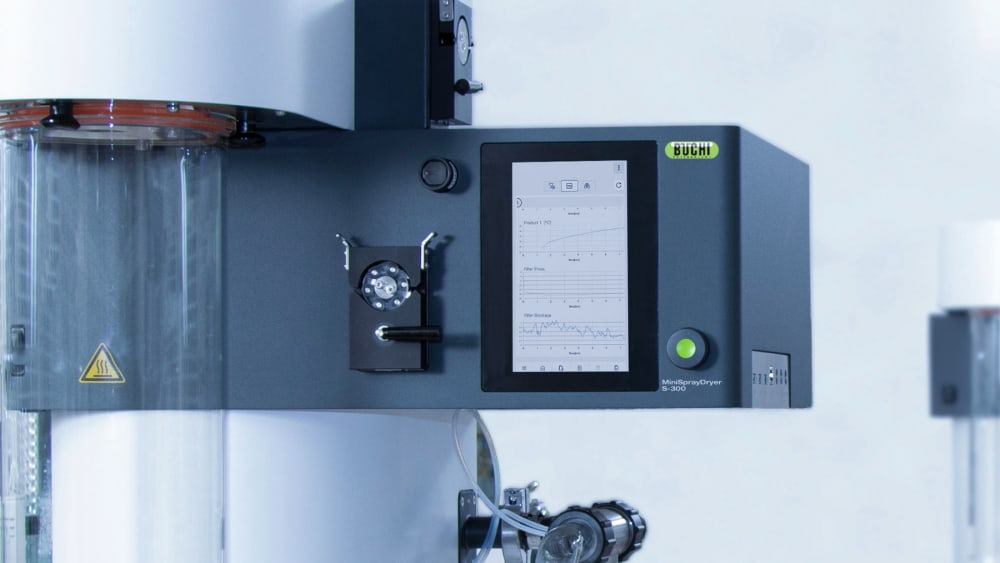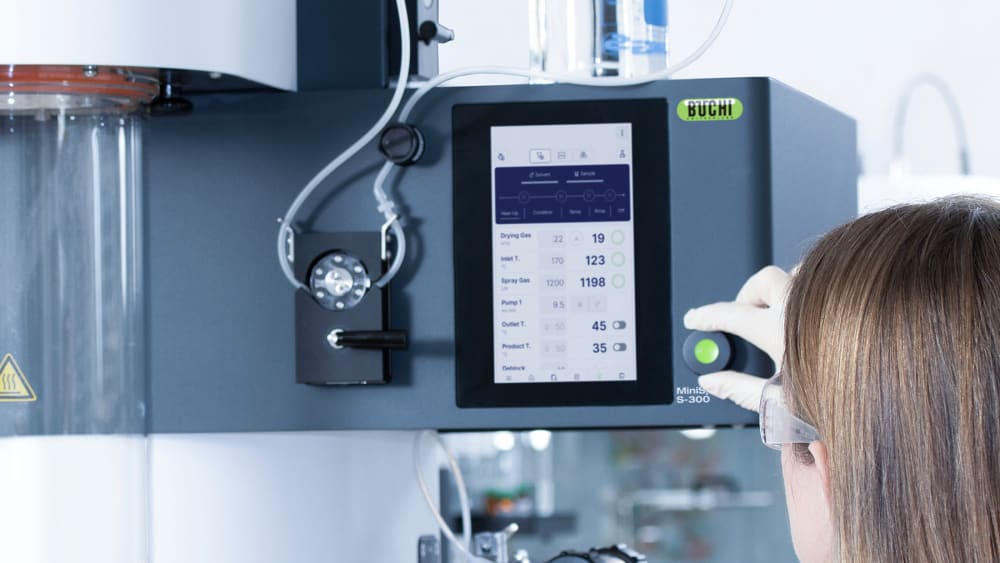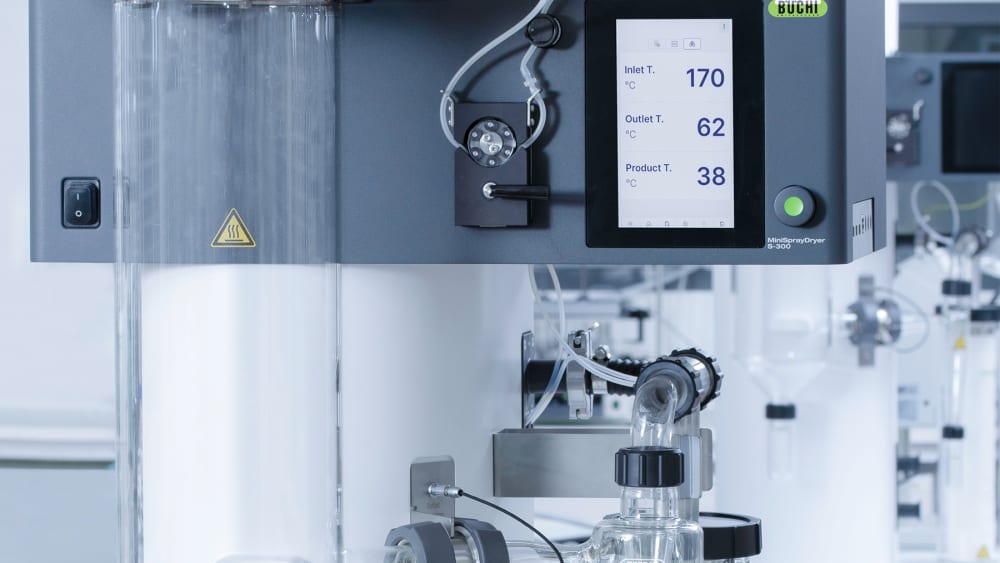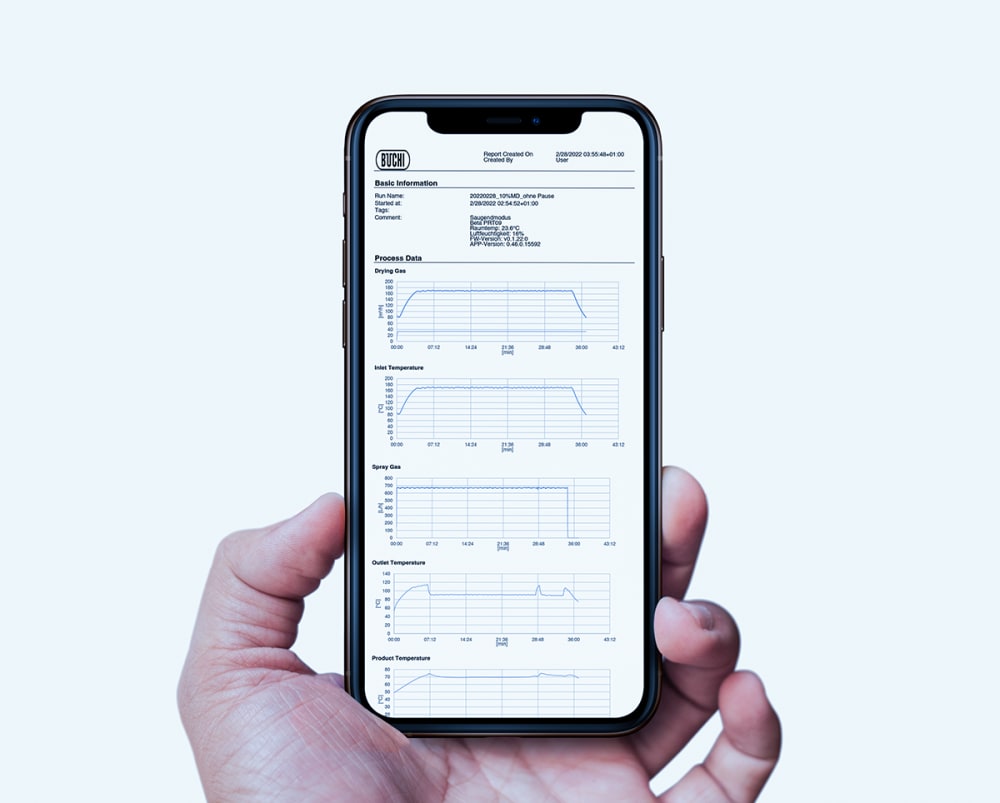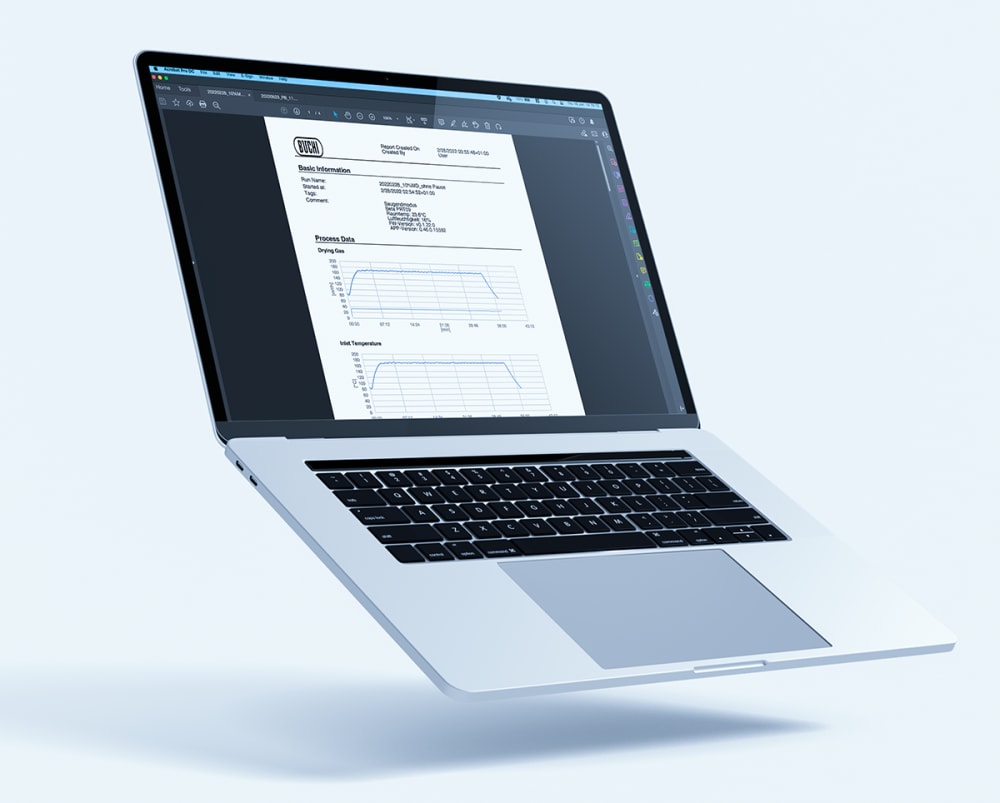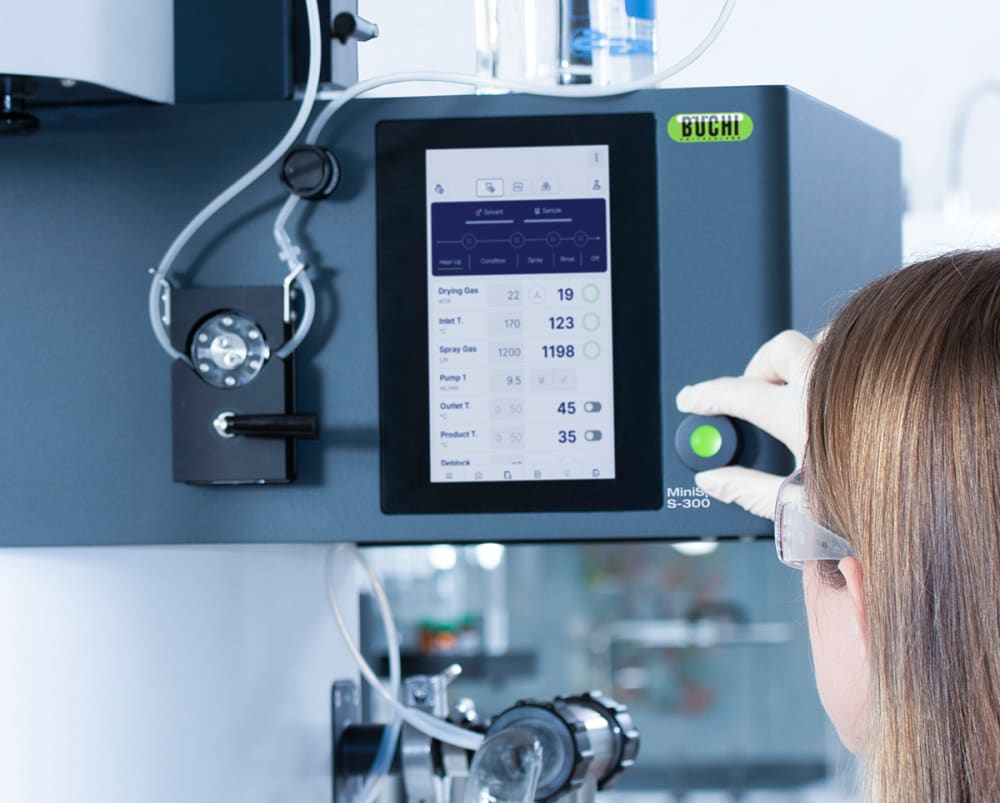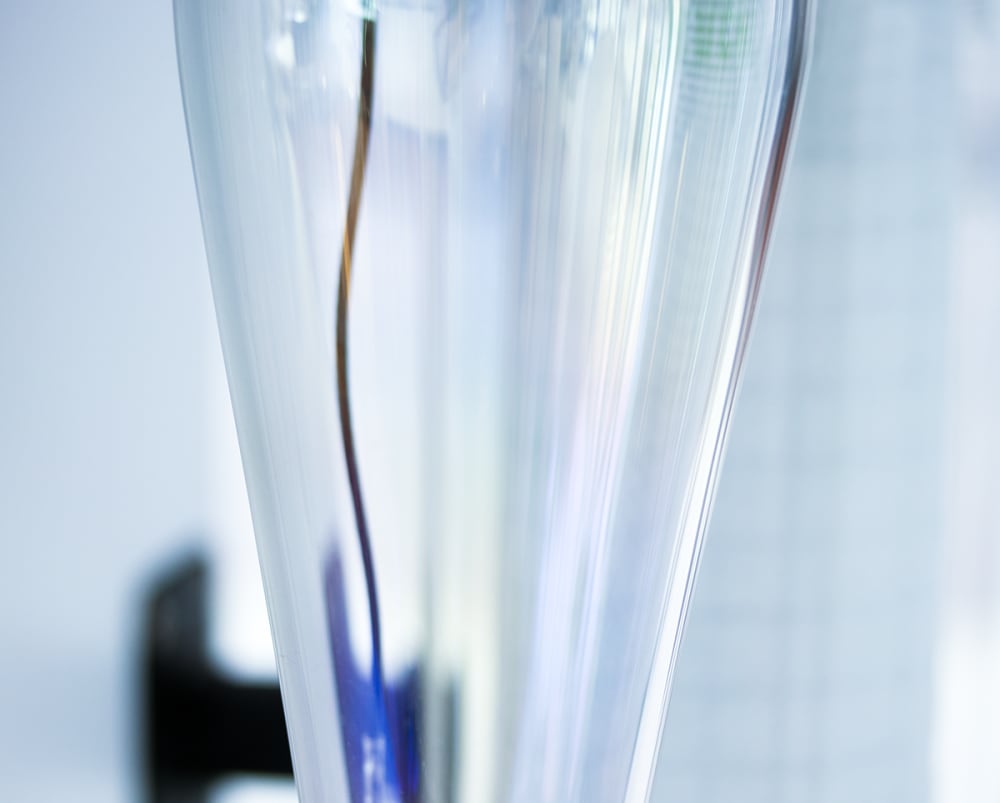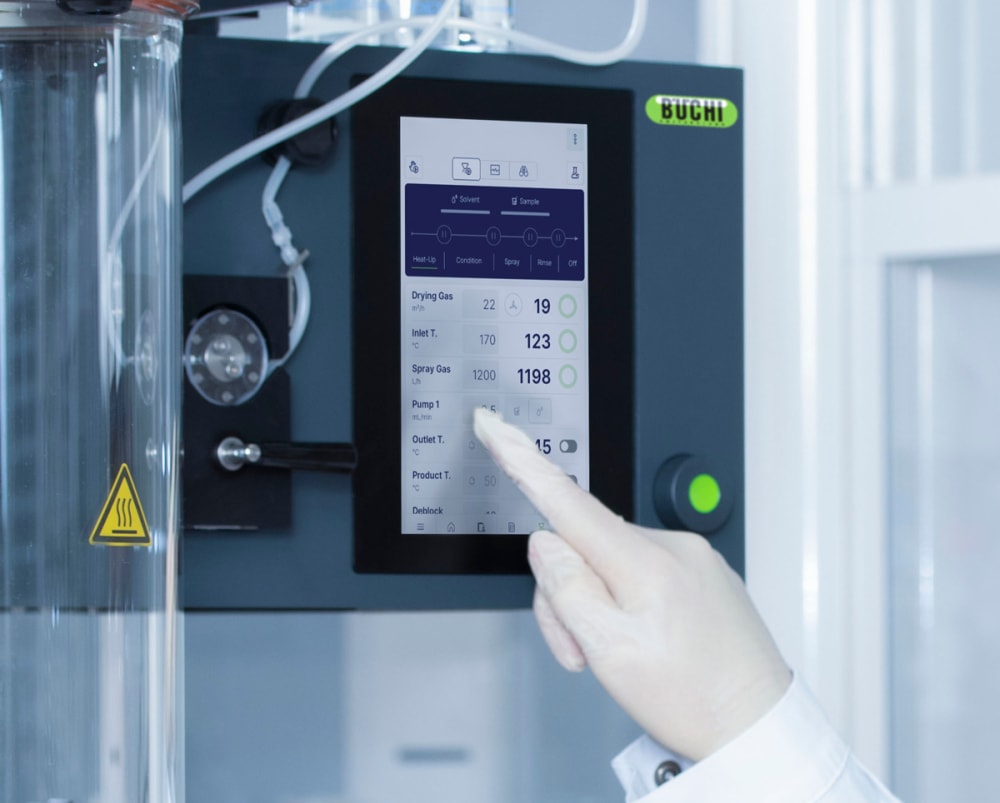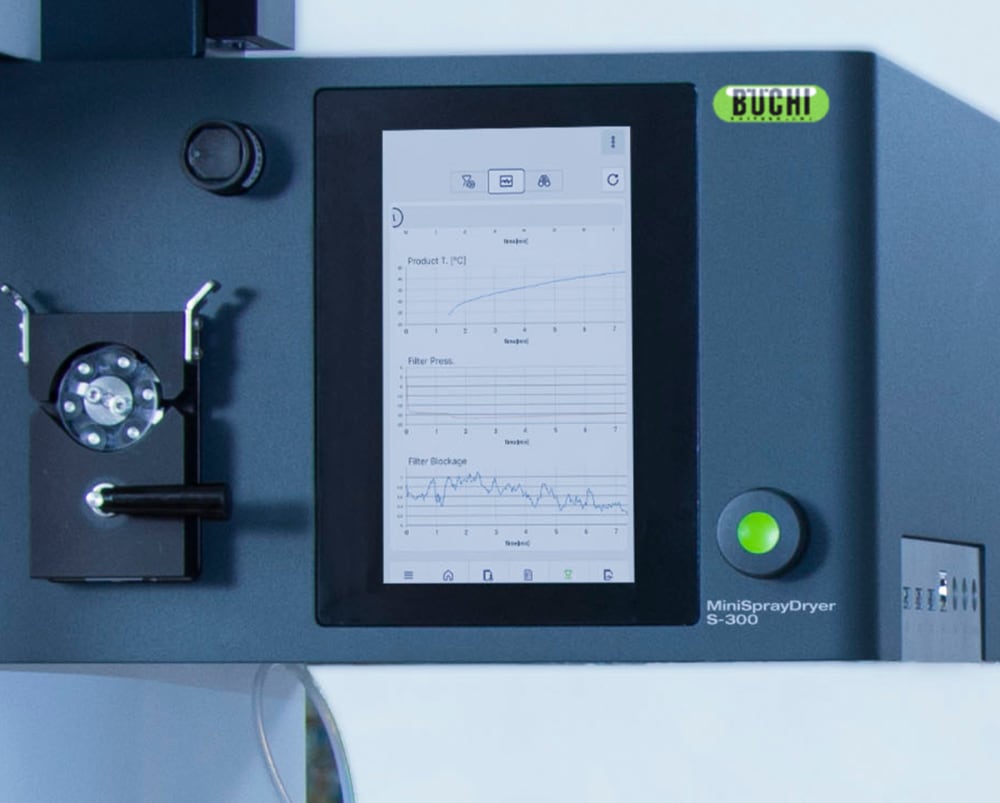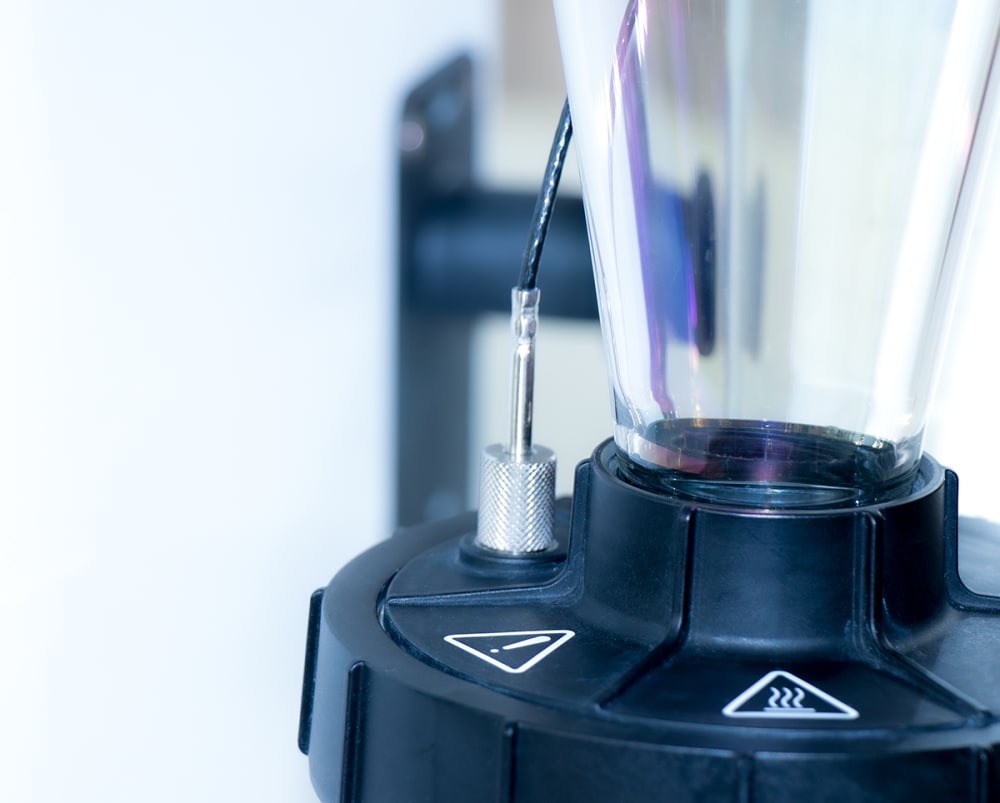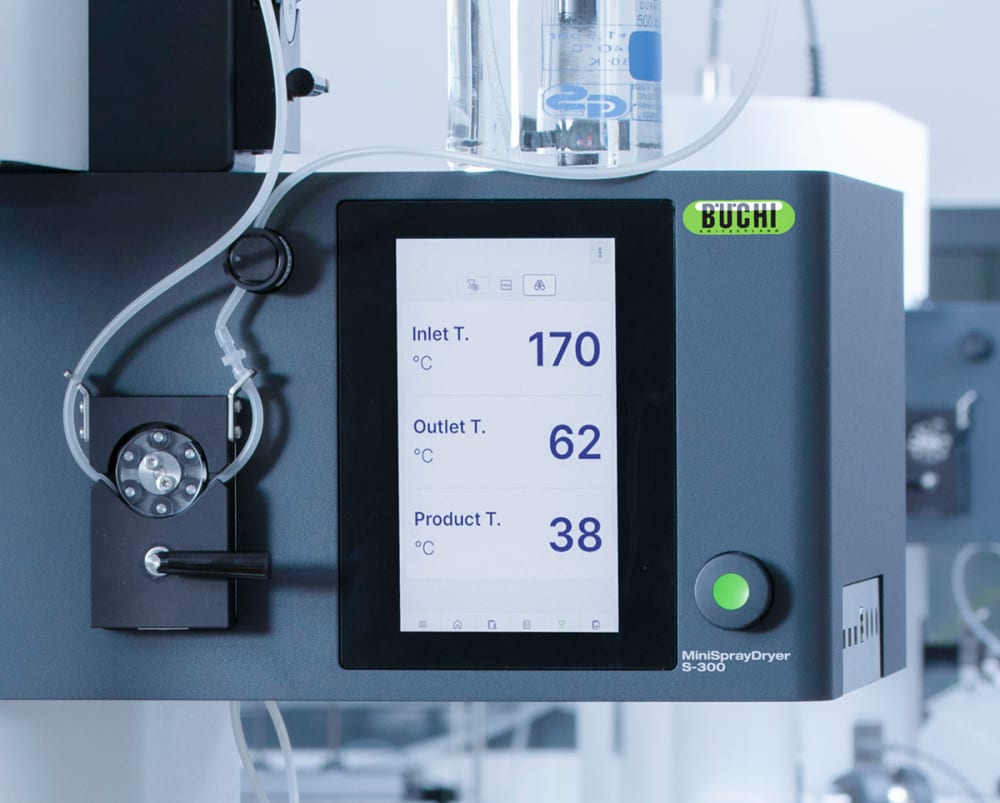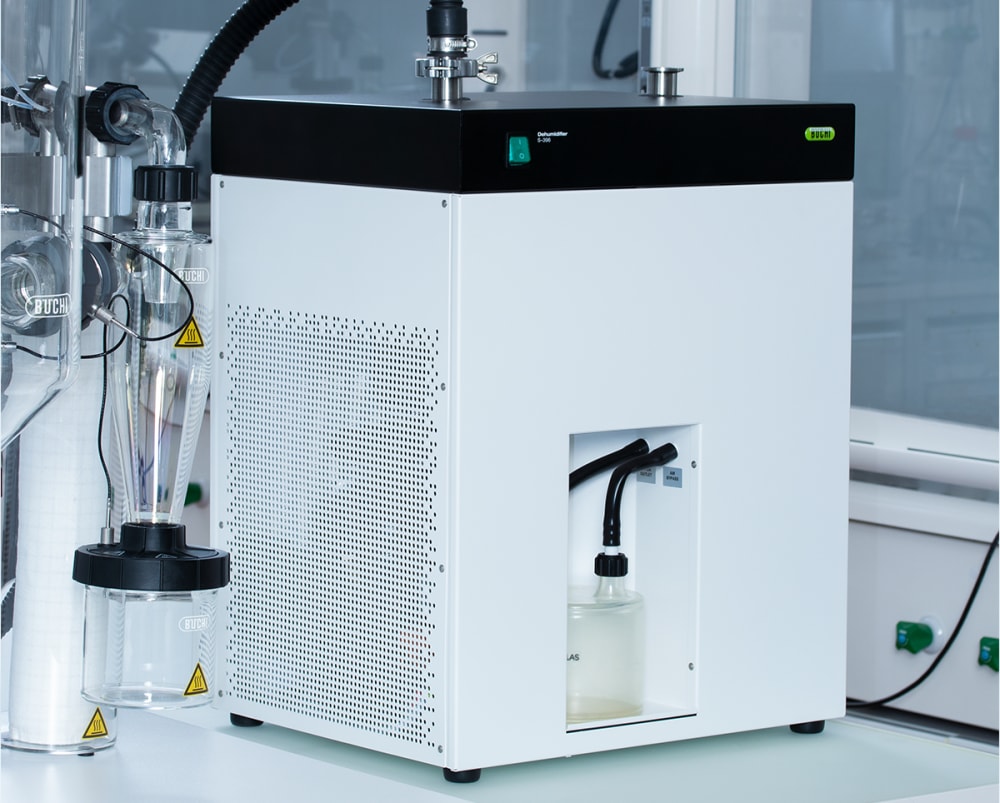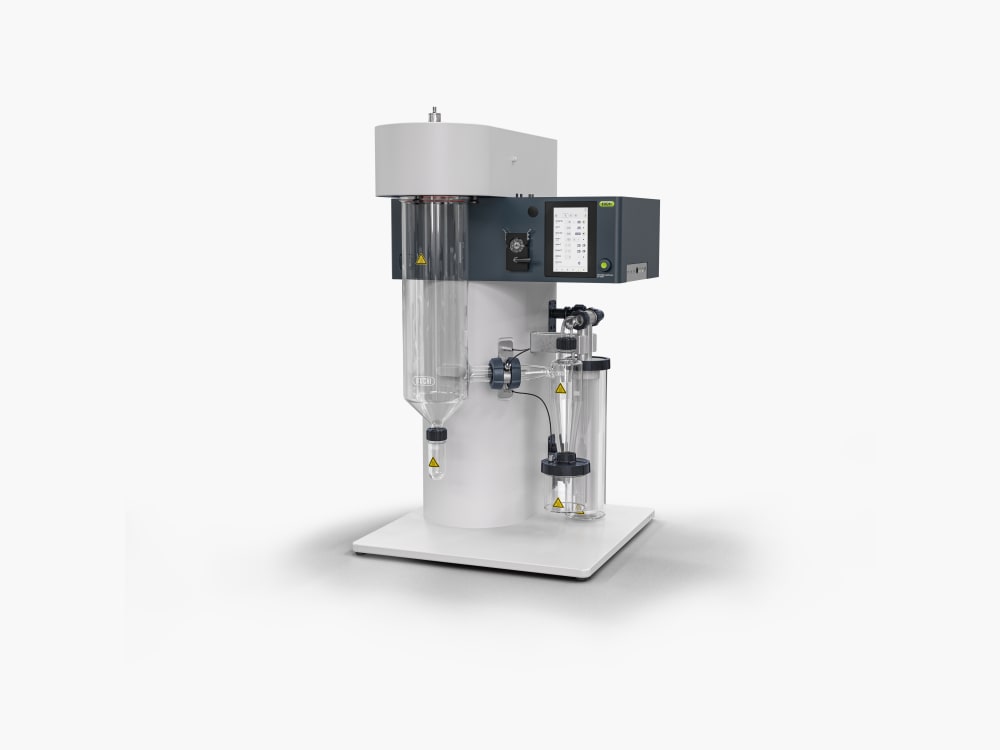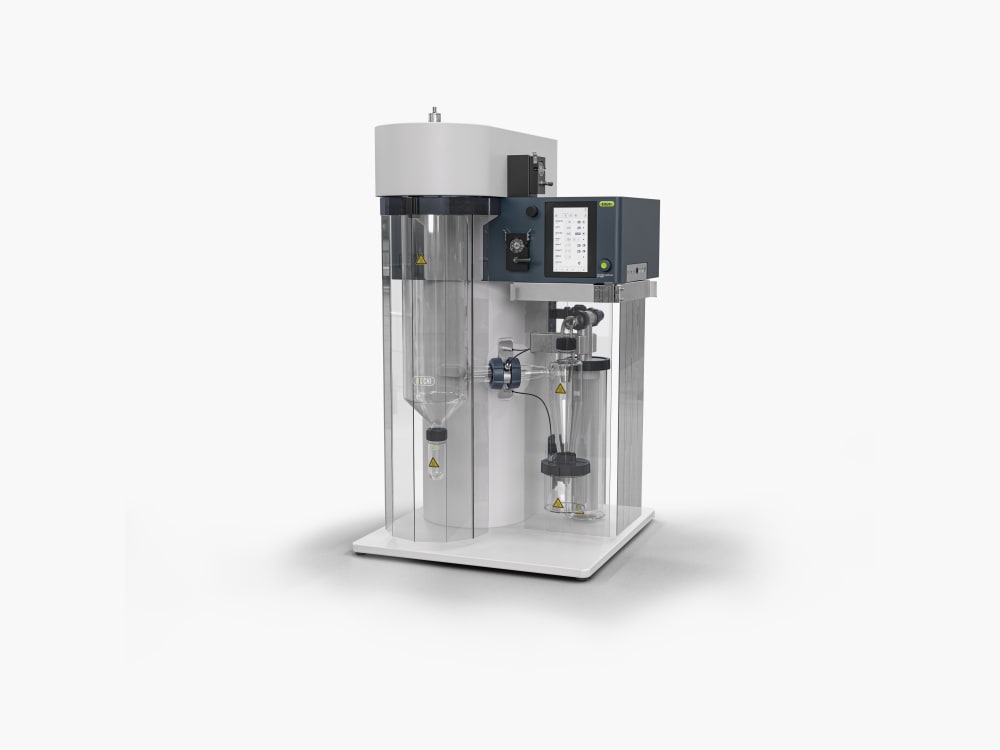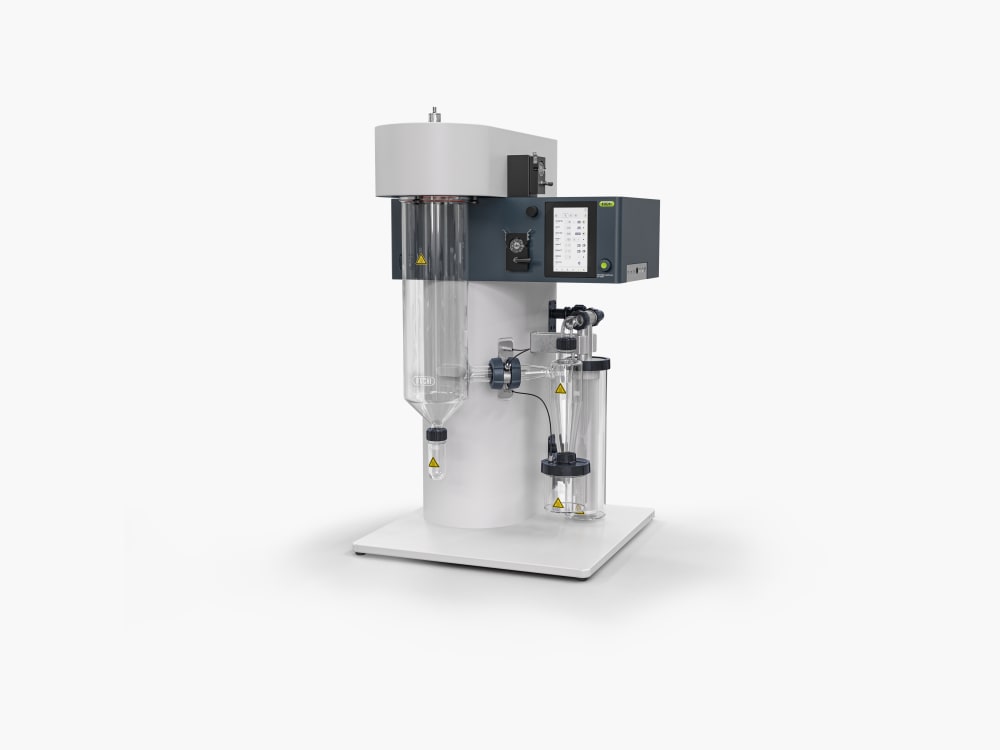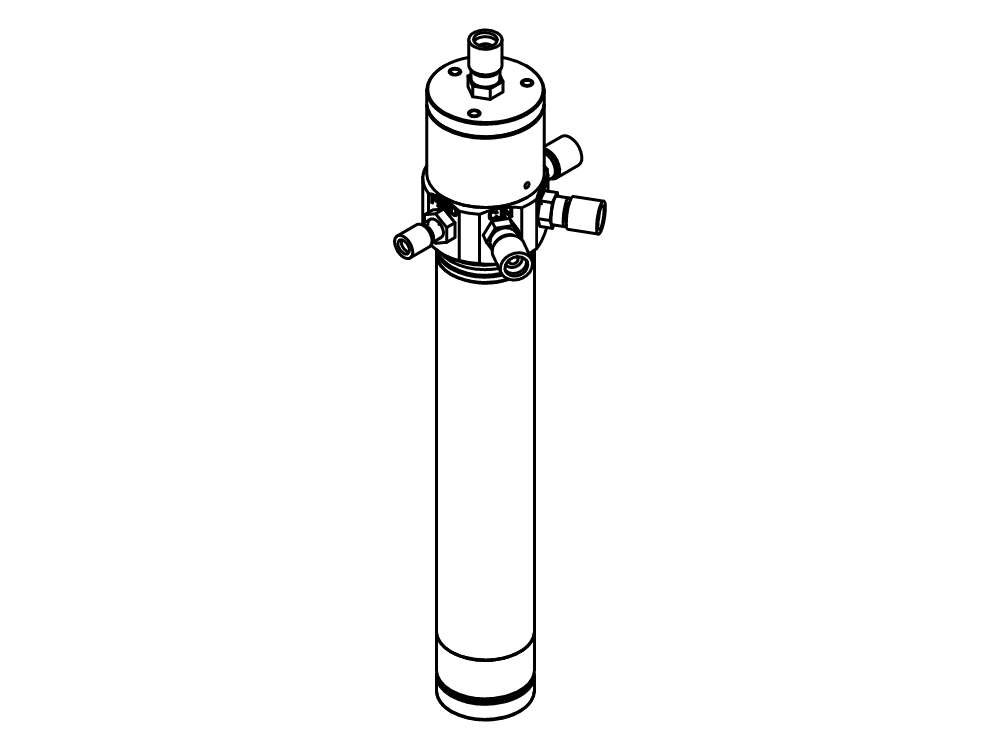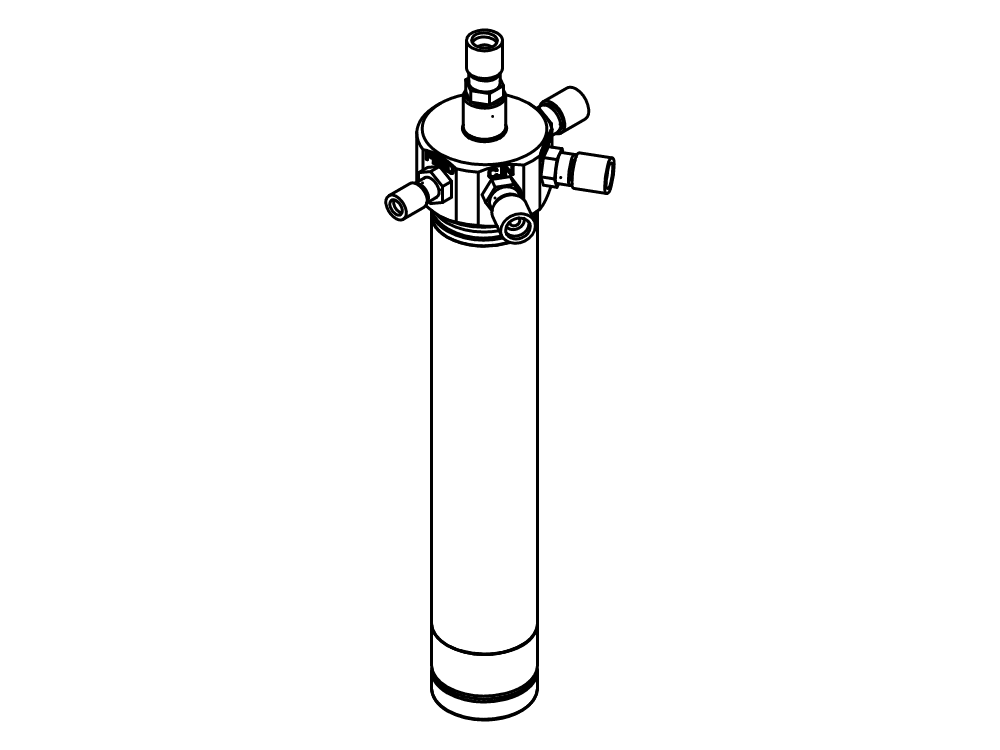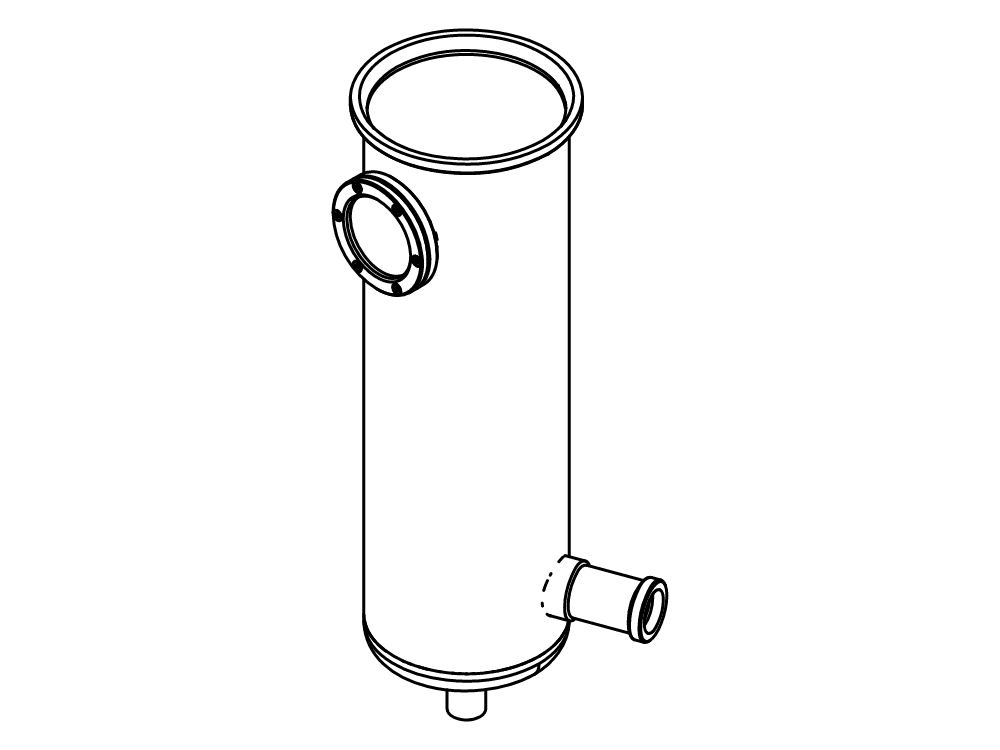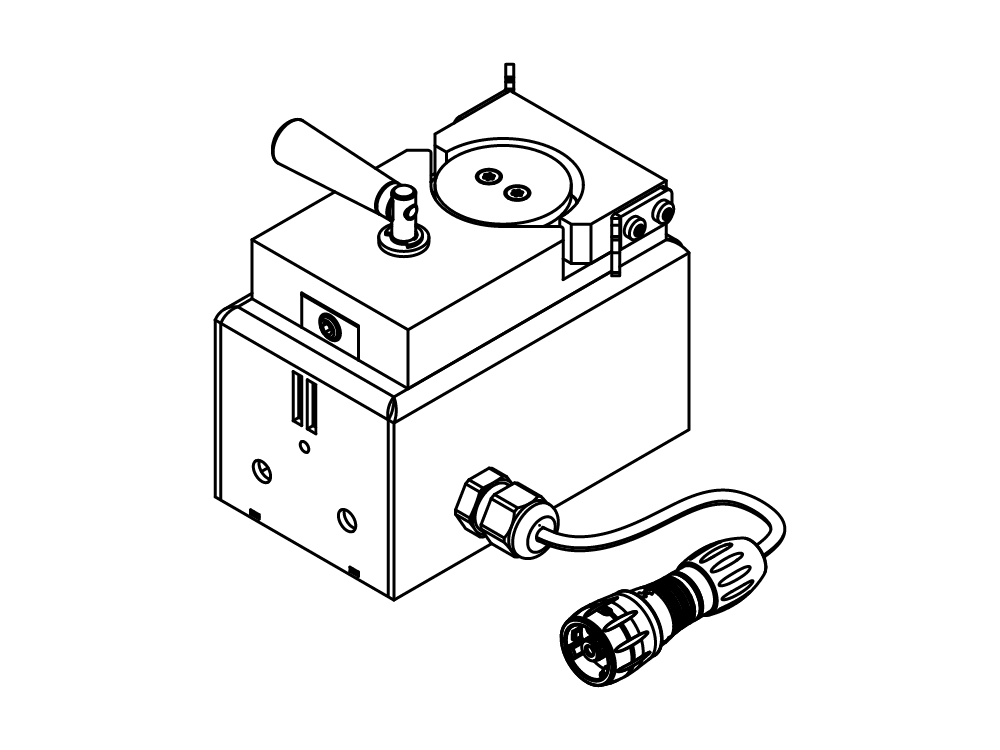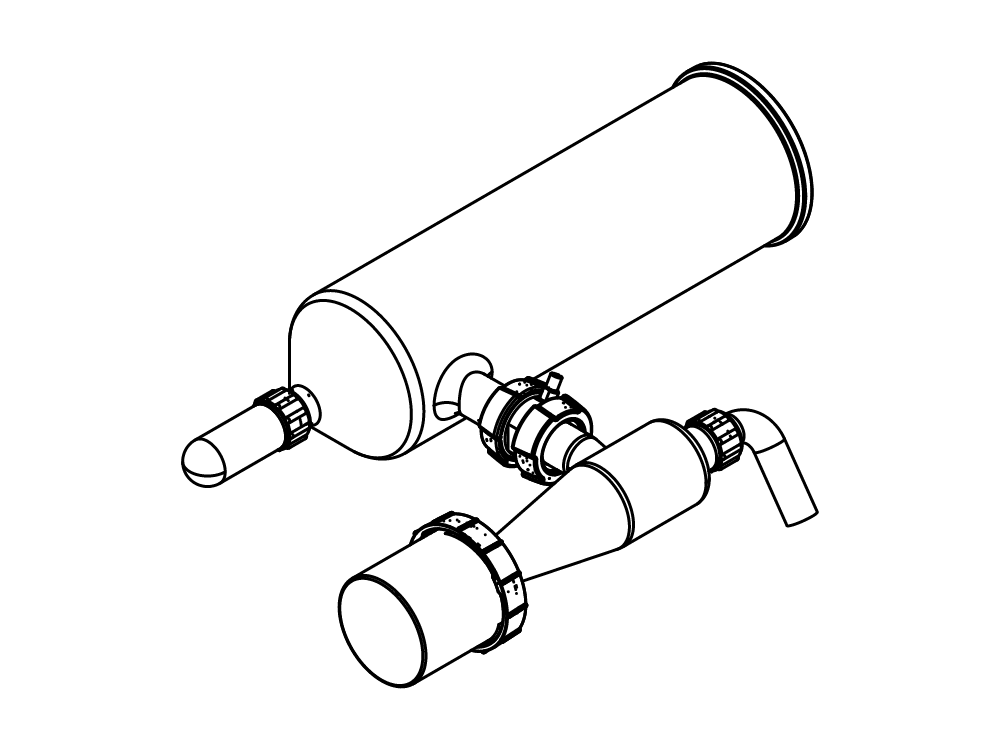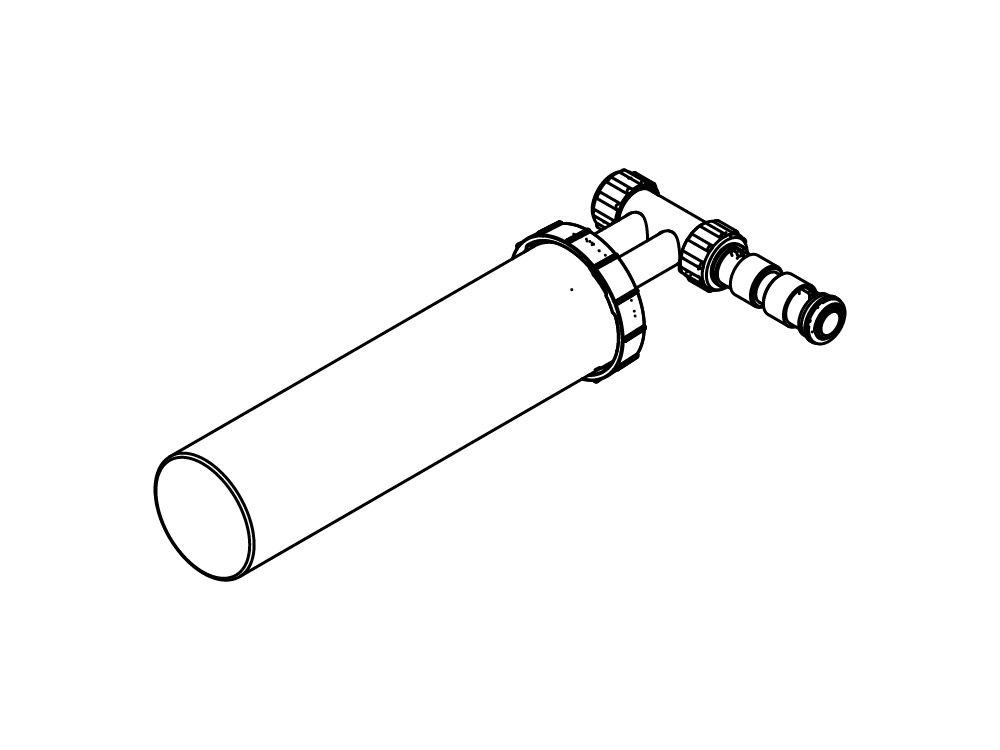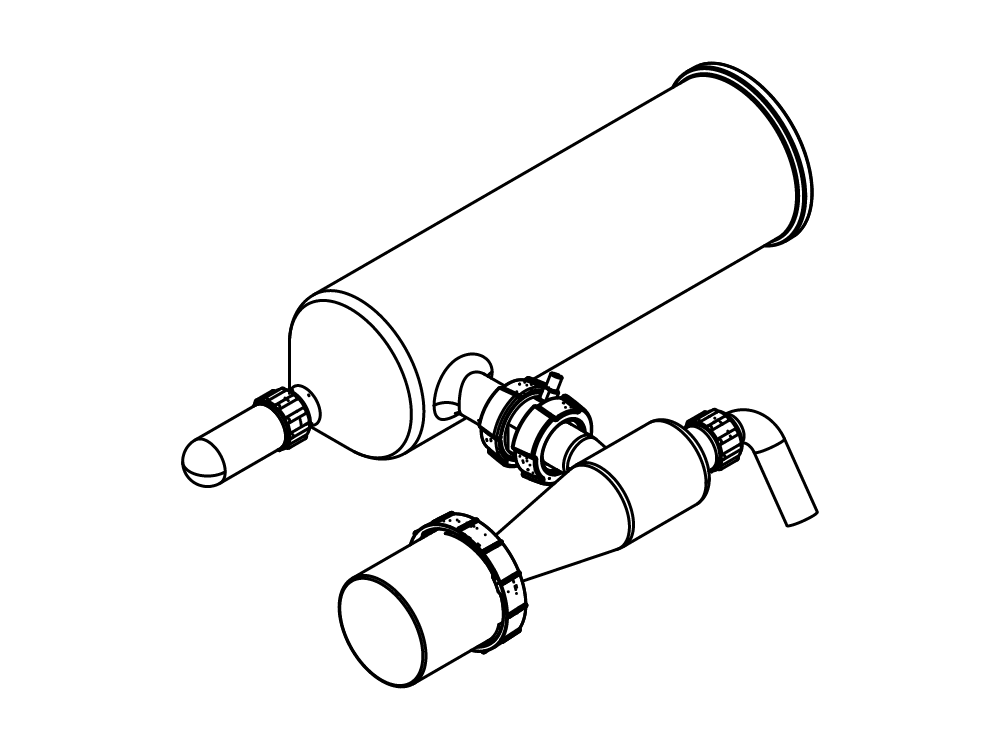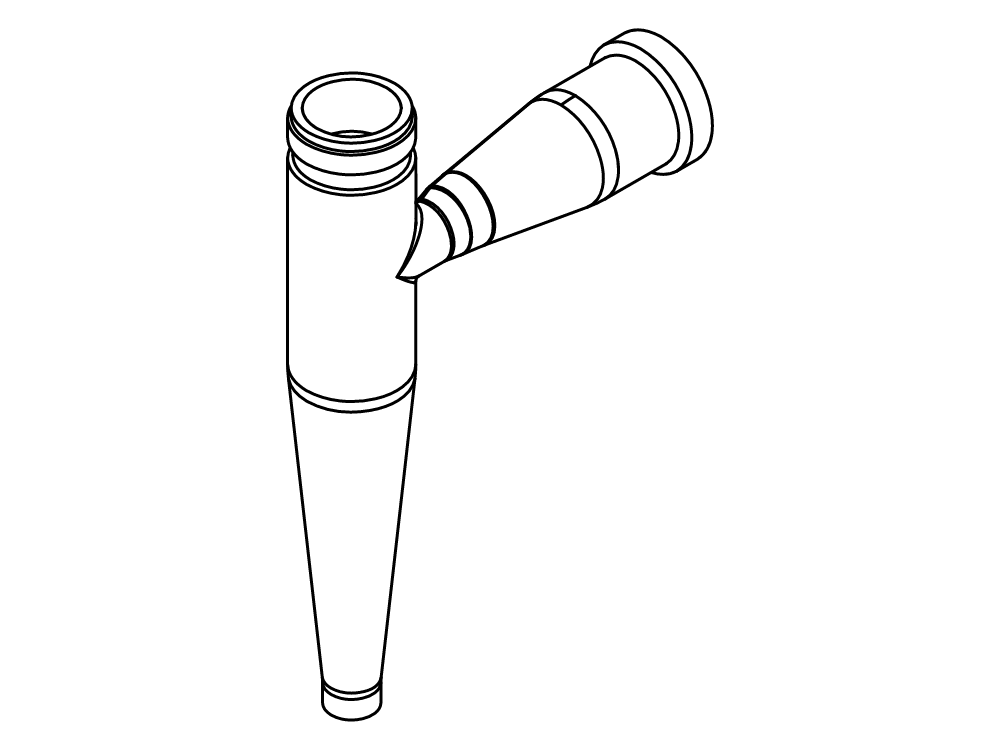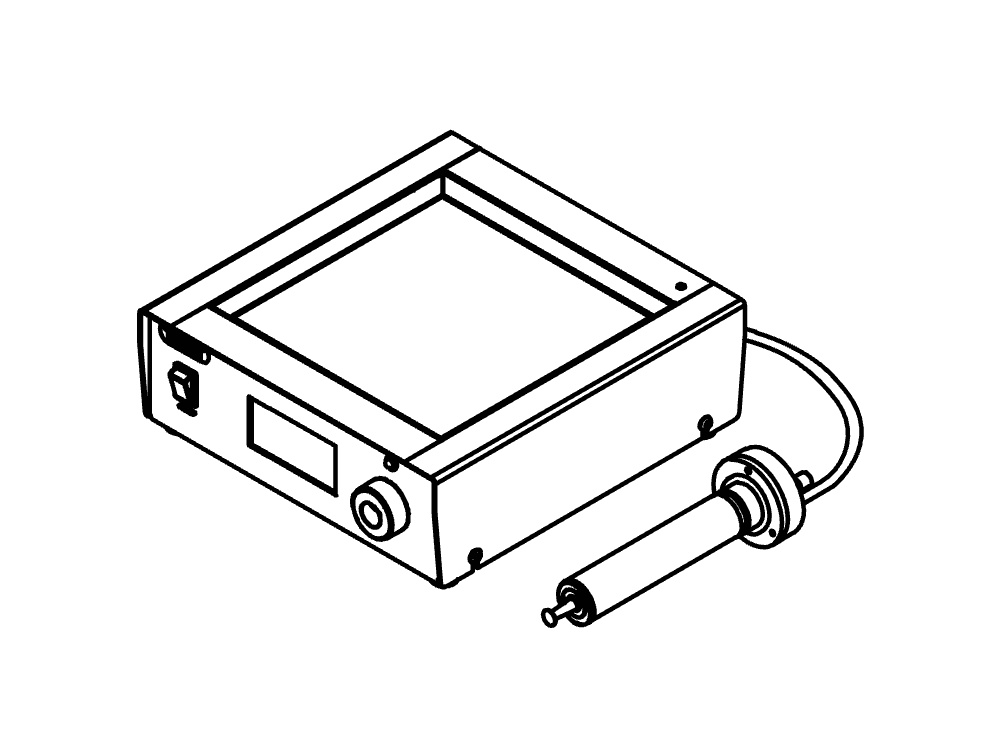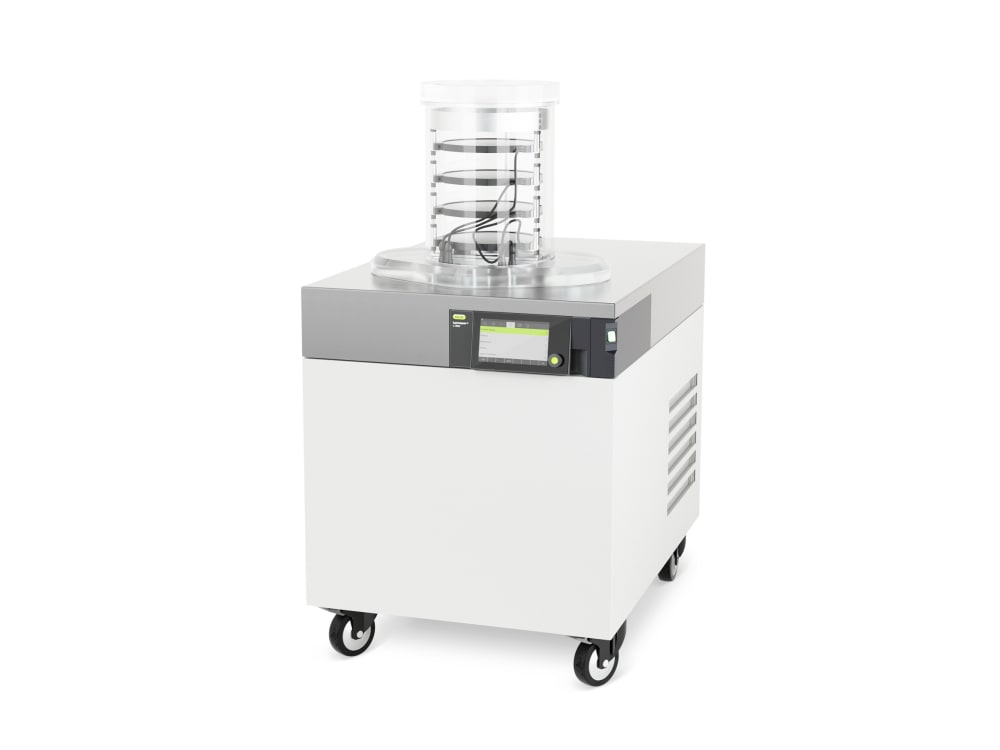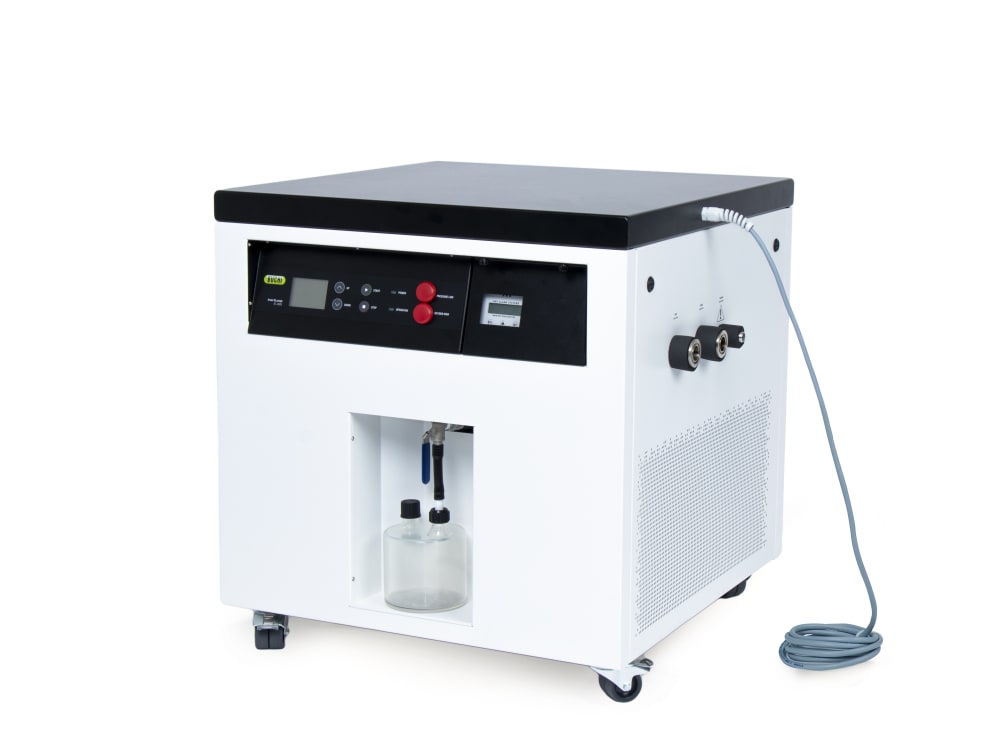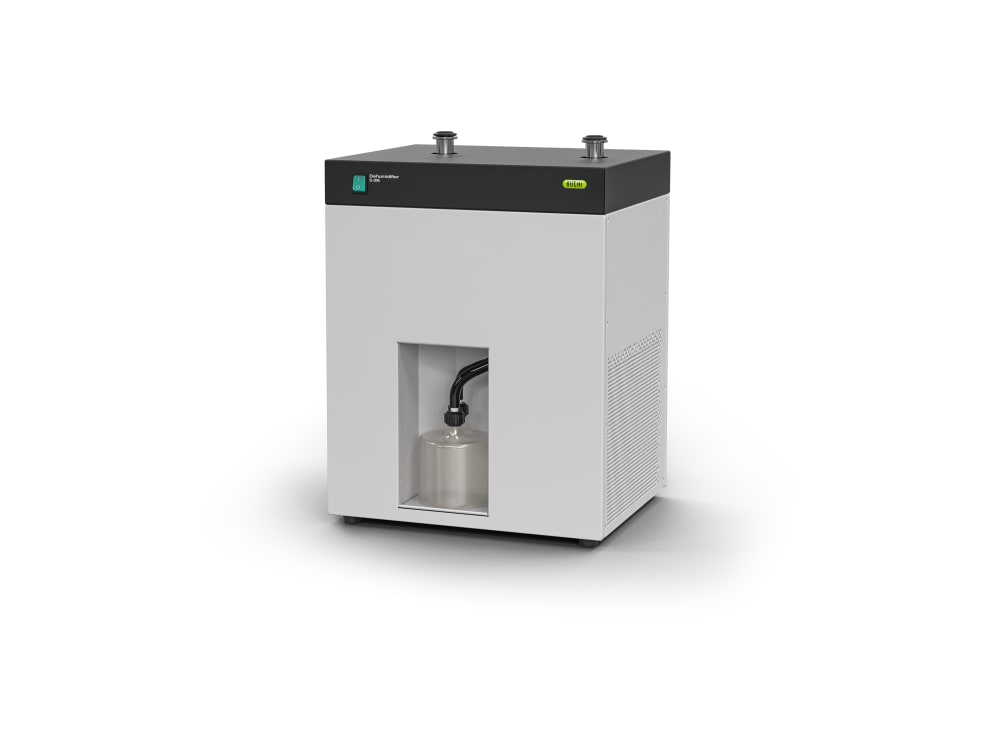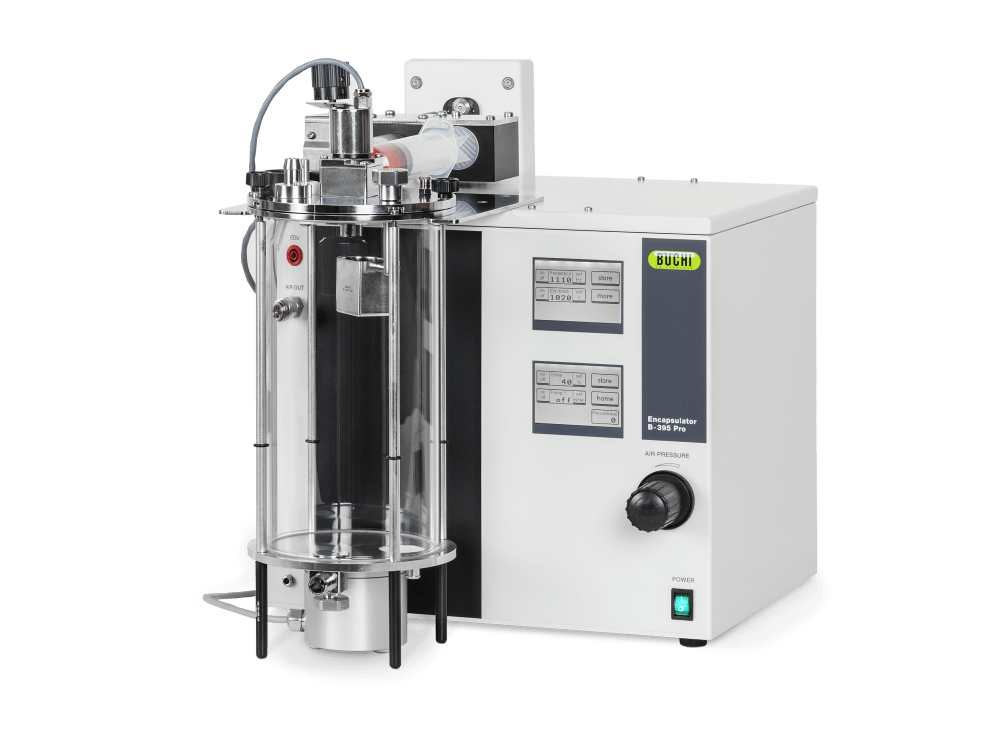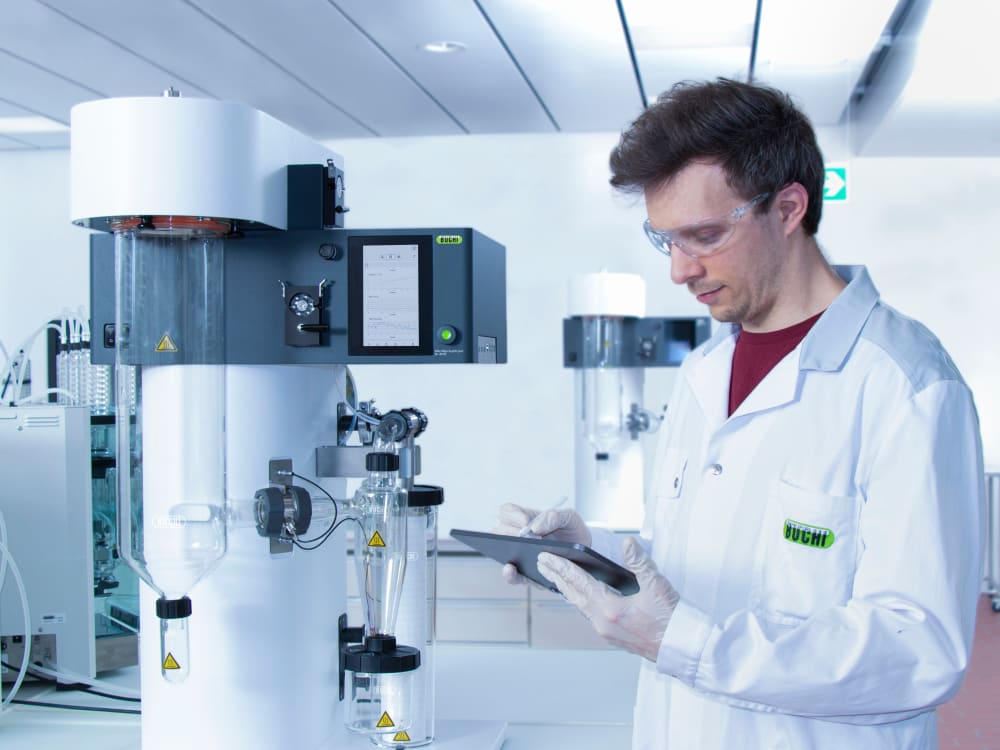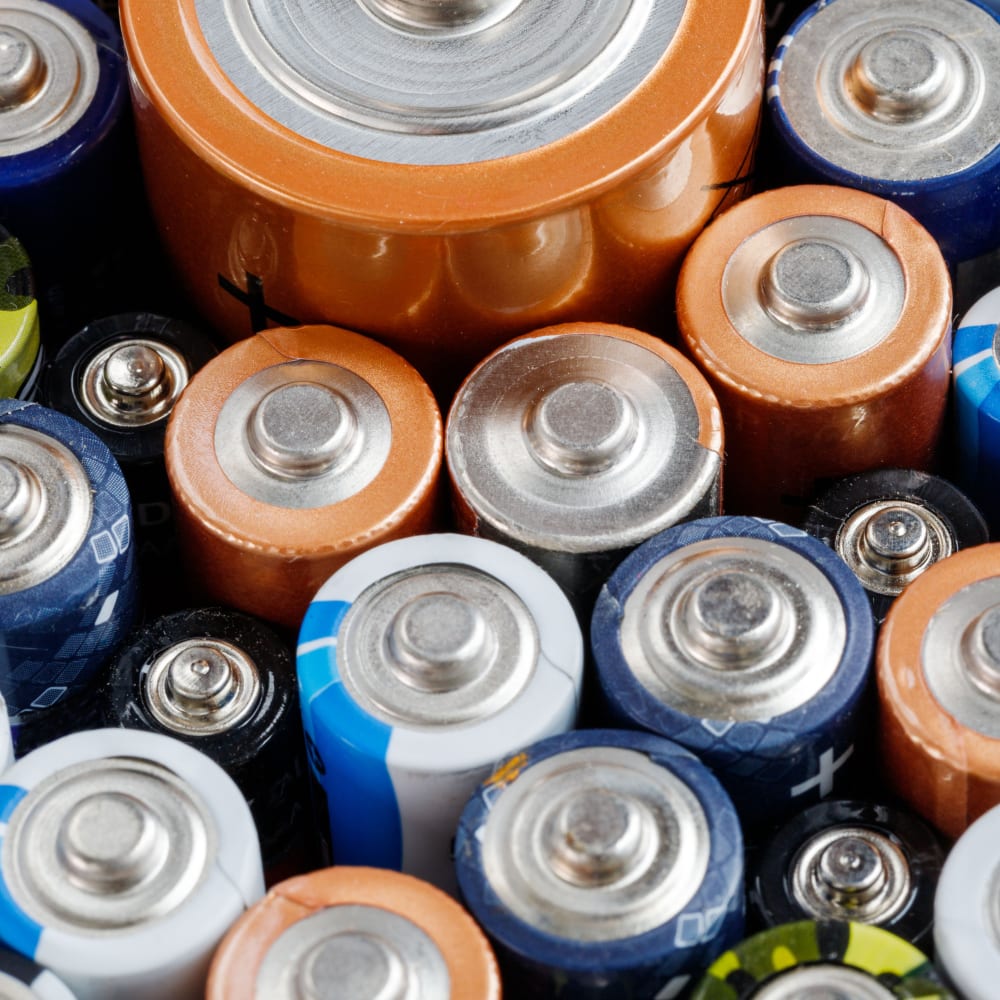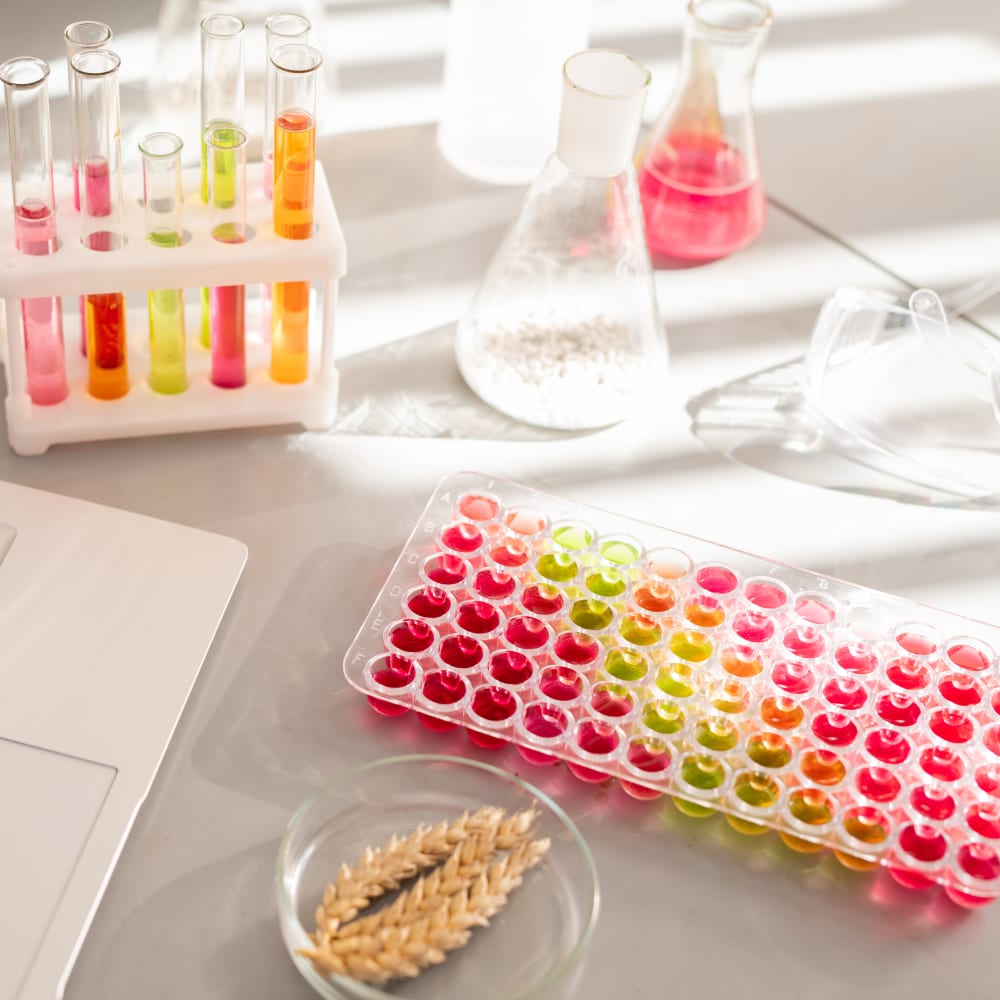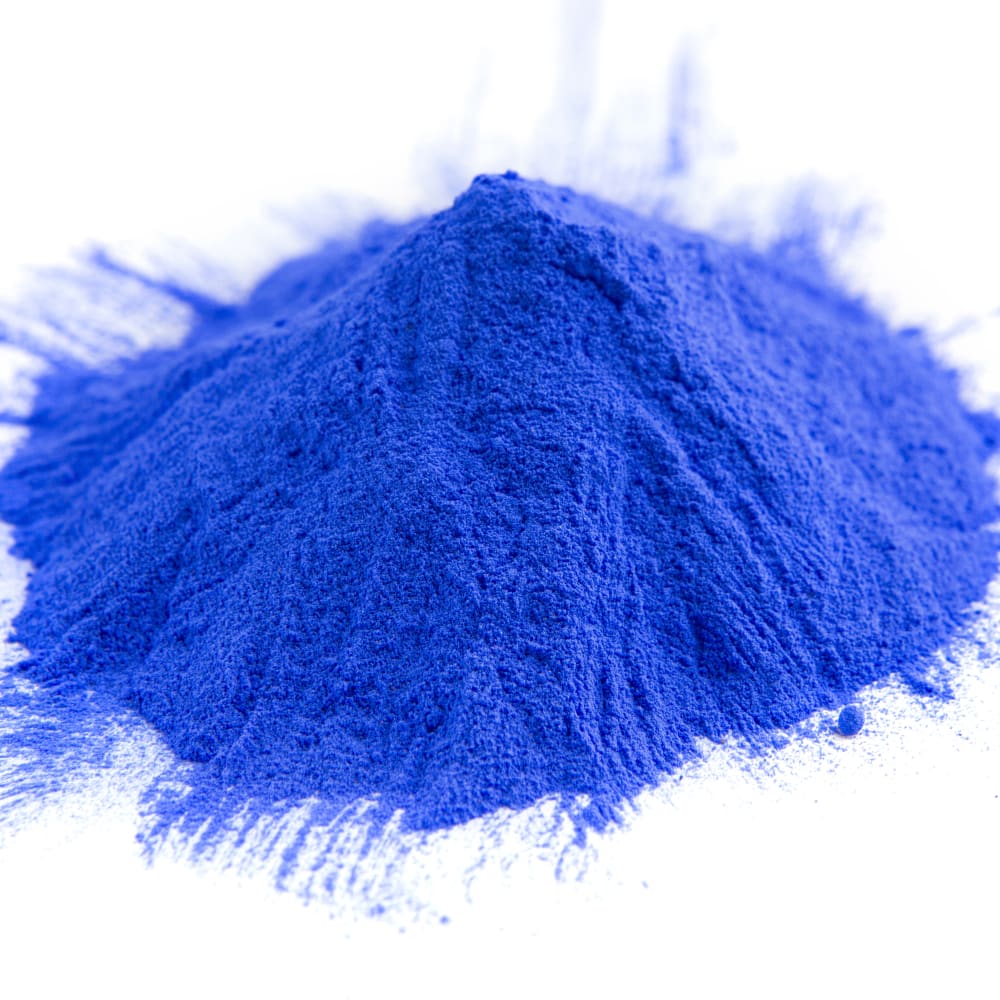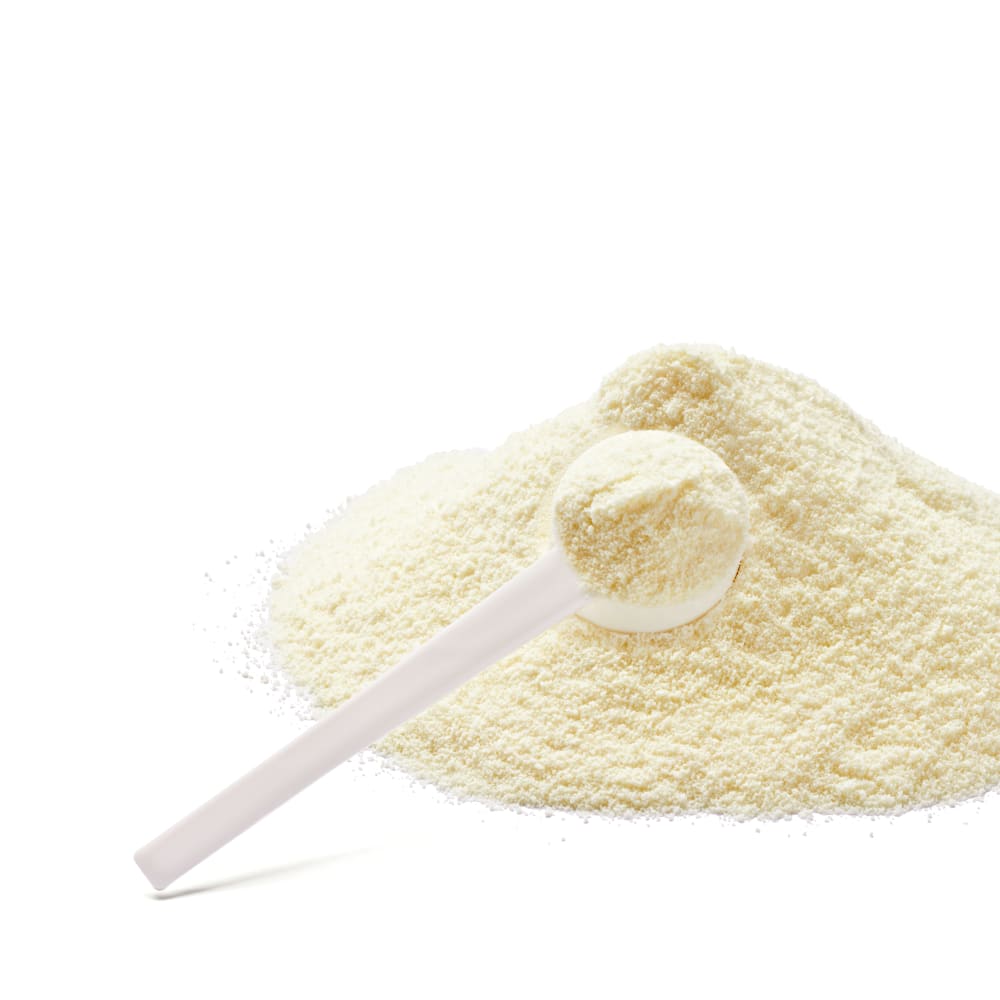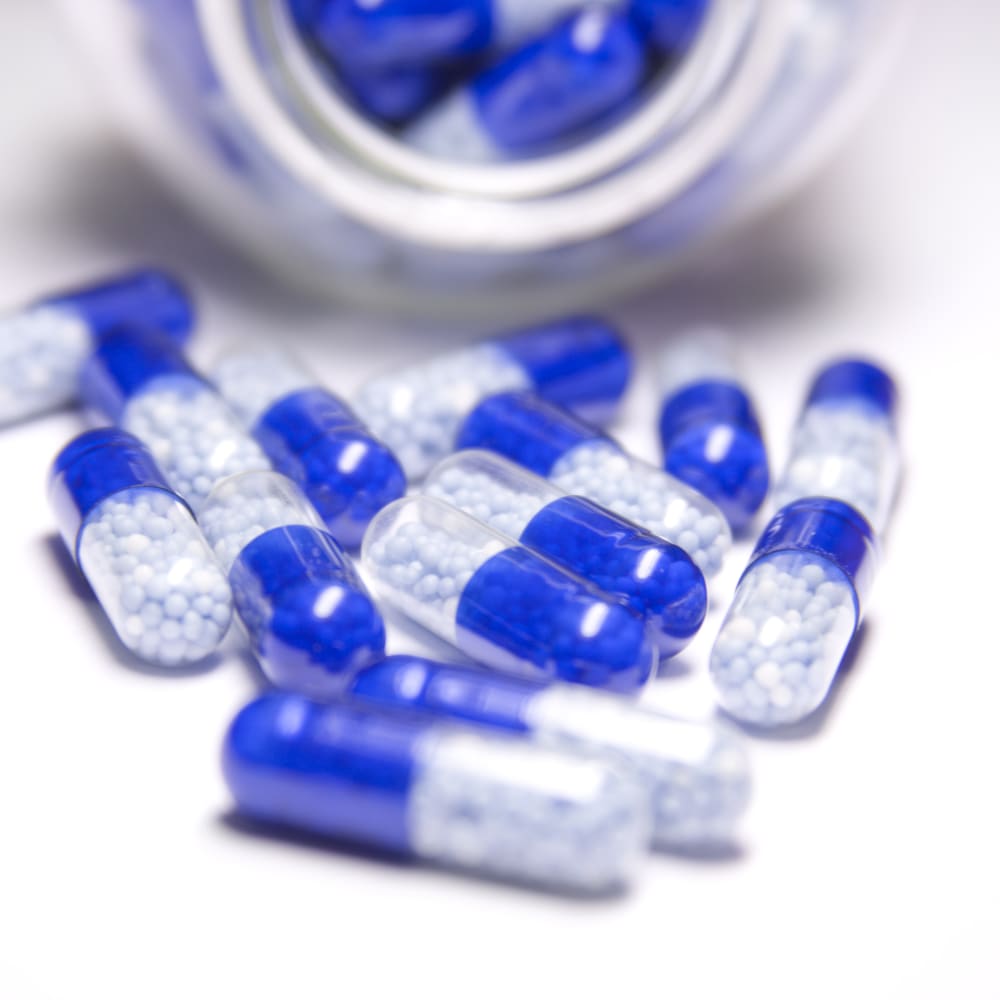Mini Spray Dryer S-300
La nueva generación de spray dryer de laboratorio
Con el Mini Spray Dryer S-300, BUCHI consolida su posición como líder internacional del mercado durante más de 40 años. El spray dryer de laboratorio combina un excepcional diseño del producto con unas funciones únicas del instrumento para ofrecer una experiencia excelente al usuario.
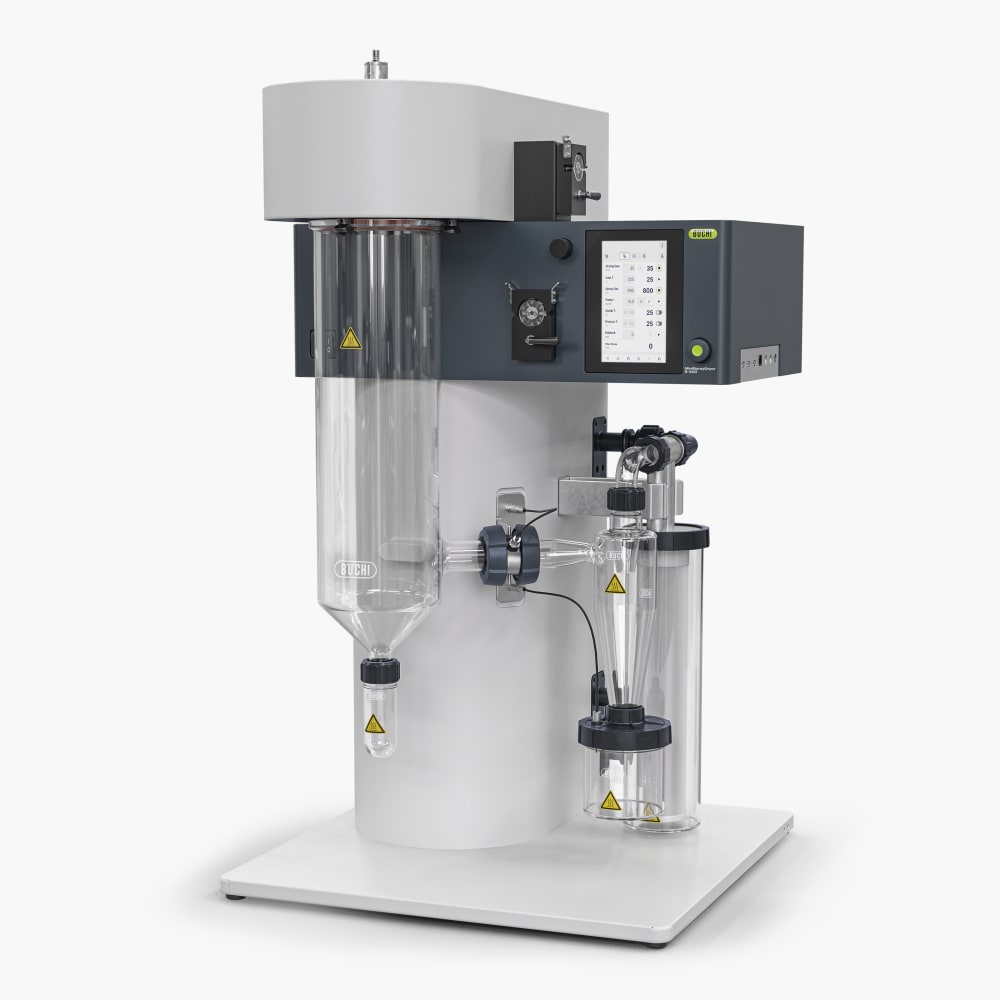
Características
- Controle o supervise el Mini Spray Dryer S-300 desde cualquier lugar en cualquier momento. Una aplicación en cualquier ordenador o dispositivo móvil le ofrece acceso completo a toda la interfaz de usuario del spray dryer de laboratorio. Gracias a las opciones de control remoto dispondrá de una gestión flexible del tiempo y un breve tiempo de reacción para procesar las alteraciones.
- Con más de 40 años de experiencia en spray drying en el laboratorio, BUCHI ha acumulado profundos conocimientos sobre las aplicaciones. Busque una de las miles de publicaciones que incluyen spray drying BUCHI en las bibliotecas científicas o explore nuestra base de datos en línea de aplicaciones de spray drying para localizar aplicaciones que se adapten a sus necesidades. Con el Mini Spray Dryer S-300, puede reproducir los resultados que haya logrado con los modelos anteriores de spray dryer de laboratorio de BUCHI. No perderá ningún trabajo valioso y podrá disfrutar de una transición rápida y sin interrupciones al nuevo instrumento.
- El modo automático le permite programar el Mini Spray Dryer S-300 Avanzado y procesar su método automáticamente. El spray dryer de laboratorio efectuará el calentamiento, acondicionará la temperatura de salida, pulverizará el disolvente, pulverizará la muestra, volverá a pulverizar disolvente y se apagará una vez procesada la muestra. El modo automático permite un uso más eficiente del tiempo en el proceso, especialmente durante tareas repetitivas.
- Reduzca la pérdida de muestra durante el spray drying en el laboratorio gracias a un ciclón con un recubrimiento conductivo que reduce la adherencia de la muestra a las paredes.
- Ahorre tiempo y molestias guardando los procesos como métodos para poder repetirlos en otro momento. También puede programar una cola de muestras para que procese una muestra tras otra en su Mini Spray Dryer S-300 para una mayor comodidad.
- Todos los procesos que realice en el MiniSpray Dryer S-300 se registrarán y se guardarán en el instrumento. Con solo pulsar un botón puede generar con facilidad un informe en PDF o un archivo .csv con los datos del proceso.
- Para ofrecerle más información acerca de las influencias térmicas en la muestra, el Mini Spray Dryer S-300 le permite supervisar tanto la temperatura de salida como la temperatura final del producto. Esta información le ayudará a proteger mejor las muestras, especialmente cuando sean muestras sensibles al calor del secado por aspersión.
- Todos los parámetros del Mini Spray Dryer S-300, como el gas de aspersión, el gas de secado y la velocidad de la bomba, se indican en valores SI y el sistema se encarga automáticamente de regularlos. Estas características maximizan la reproducibilidad del proceso.
- Cuando se combina con el Inert Loop S-395, el Mini Spray Dryer S-300 le permite manipular de manera segura las muestras con disolventes orgánicos. El gas de secado de nitrógeno se hace circular y el disolvente se recoge en forma de condensado. Para garantizar la seguridad, el nivel de oxígeno y el flujo de gas del sistema se supervisan de manera continua.
Compare the Mini Spray Dryer S-300
Partes & Accesorios relacionados
Descargas
- Technical Data Sheet Mini Spray Dryer S-300(pdf)
- Product Brochure Mini Spray Dryer S-300 en(pdf)
- Product Brochure Pharma and Chemistry en(pdf)
- Operation Manual Mini Spray Dryer S-300 en(pdf)
- Installation Manual Mini Spray Dryer S-300 in closed mode with Inert Loop(pdf)
- Installation Manual Mini Spray Dryer S-300 in closed mode with Dehumidifier and Inert Loop(pdf)
- Installation Manual Mini Spray Dryer S-300 in open suction mode(pdf)
- Installation Manual Mini Spray Dryer S-300 in open pressure mode(pdf)
- Configuration guide S-300(pdf)
- Pre-Installation Checklist Mini Spray Dryer S-300(pdf)
Instrumentos relacionados
Cursos & Capacitaciones relacionados
Aplicaciones
Unmatched flexibility for a full range of applications
Batteries
Laboratory-scale spray drying is a valuable technique in battery research for the fabrication of electrode materials. It enables precise control over particle size and morphology, resulting in electrodes with optimized electrochemical performance. Spray drying allows for the production of fine and uniform particles, contributing to the development of high-performance batteries. This method facilitates the development of electrode materials with enhanced properties, such as improved conductivity and electrochemical stability. By employing laboratory-scale spray drying in battery research, scientists can advance energy storage technologies and develop more efficient and reliable batteries for various applications.
Biotech
Applications: Cells, bacteria and protein encapsulation, cell transplantation, biotransformation Methods: Drying, encapsulation of liquids, Encapsulation of solids, Micronization, Cell encapsulation Instruments used: Mini Spray Dryer S-300, Nano Spray Dryer B-90, Encapsulator B-390 / B-395, Lyovapor L-200 / L-300
Chemicals / Materials
Laboratory-scale spray drying is a versatile and efficient method for producing a wide range of materials in the chemicals and materials science field. In recent years, notable trends have emerged, including the application of spray drying for nano materials, paints and coatings, and catalysts. One trend is the use of laboratory-scale spray drying in the synthesis of nano materials. This technique enables the production of nanoparticles and nanostructured materials with controlled size, morphology, and composition. By tailoring these properties, researchers can develop advanced materials with improved mechanical strength, enhanced conductivity, and tailored surface functionalities. Spray drying also finds application in the production of paints and coatings. By producing fine and uniform particles, spray drying contributes to the desired properties of coatings, such as improved color, durability, and film formation. This trend leads to the development of high-quality coatings with enhanced performance and functionality. Furthermore, laboratory-scale spray drying plays a role in the development of catalysts. By controlling particle size, composition, and surface area, spray drying allows for the design and optimization of catalysts for efficient chemical transformations and environmental applications. In summary, laboratory-scale spray drying in the chemicals and materials science field is witnessing trends in nano materials, paints and coatings, and catalysts. These trends contribute to the development of advanced materials, high-performance coatings, and efficient catalysts, driving innovation in various industries.
Cosmetics
Applications: Cosmetics, fragrances Methods: Drying, encapsulation of liquids, Encapsulation of solids, Micronization Instruments used: Mini Spray Dryer S-300, Encapsulator B-390 / B-395, Lyovapor L-200 / L-300
Food
Applications: Encapsulation of additives, controlled release, nutraceuticals, functional foods, flavors, vitamins, proteins, probiotic bacteria, juice concentrate, milk powder Methods: Drying, encapsulation of liquids, Encapsulation of solids, Micronization Instruments used: Mini Spray Dryer S-300, Encapsulator B-390 / B-395, Lyovapor L-200 / L-300
Pharma
Laboratory-scale spray drying is a vital process in the pharmaceutical industry, used for the formulation and development of various drugs and medications. It involves converting liquid solutions or suspensions into dry powders through atomization and rapid evaporation. This technique offers several benefits, including improved stability, enhanced bioavailability, and ease of handling. In recent years, several notable trends have emerged in laboratory-scale spray drying within the pharmaceutical sector. One significant trend is the use of spray drying for the production of solid dispersions. Solid dispersions are formulations where the drug is dispersed in a solid matrix, enhancing its solubility and dissolution rate. Spray drying enables the preparation of solid dispersion powders with uniform drug distribution, leading to improved drug delivery and efficacy. Another trend is the development of inhalable drugs using spray drying. This technique allows for the production of dry powder formulations suitable for inhalation, facilitating targeted delivery to the respiratory system. Inhalable drugs offer advantages in the treatment of respiratory diseases, such as asthma and chronic obstructive pulmonary disease (COPD). Taste masking is another important application of laboratory-scale spray drying. By encapsulating drugs with unpleasant taste profiles in taste-masking particles, the palatability of oral formulations can be improved. Spray drying enables the encapsulation of drugs within taste-masking coatings, leading to better patient compliance, particularly for pediatric and geriatric populations. Furthermore, laboratory-scale spray drying is increasingly employed for the development of controlled-release formulations. By incorporating drugs into sustained-release matrices or encapsulating them within microspheres or nanoparticles, spray drying allows for the controlled release of drugs over an extended period. This enables optimized drug dosage regimens and improved patient convenience. In conclusion, laboratory-scale spray drying in the pharmaceutical area is witnessing several significant trends, including the production of solid dispersions, inhalable drugs, taste-masking formulations, and controlled-release systems. These trends contribute to the development of novel drug formulations with enhanced solubility, targeted delivery, improved patient compliance, and optimized drug release profiles.
